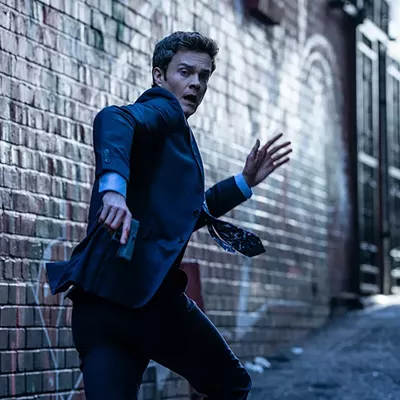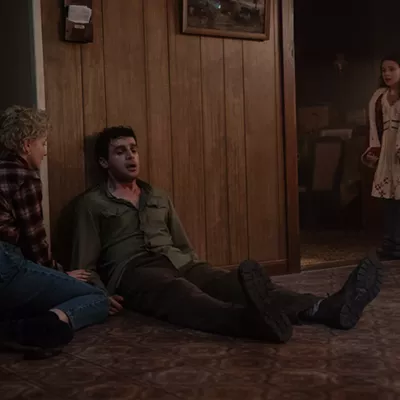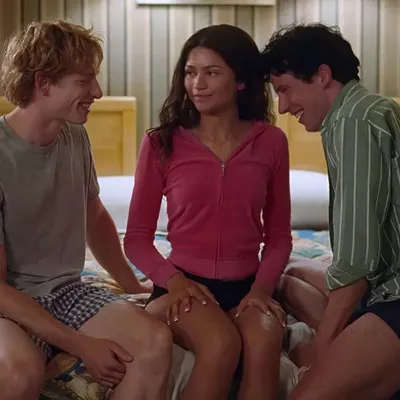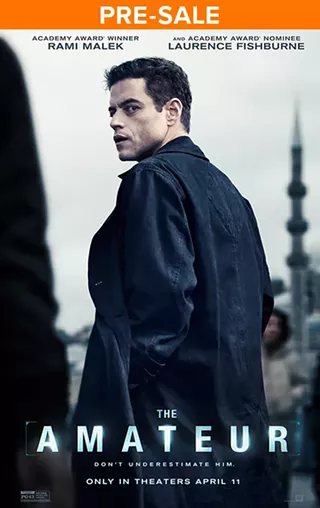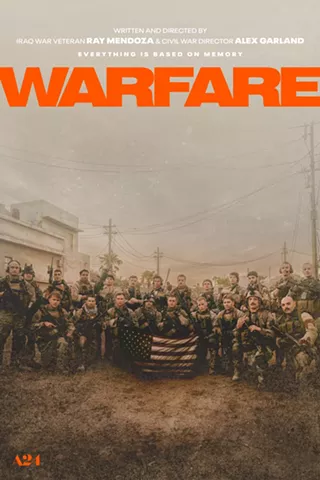But clearly, the best use of film's dynamic force is in the talking-heads sequence, where two characters sit in chairs (chairs!) and talk to each other. There's a name for that kind of scene: pulse-pounding action!
Lions for Lambs weaves together three scenarios. In two of them, people have actual conversations using words and, occasionally, gestures. In the other, a crew of Marines tries to take a snowy hilltop from Taliban fighters. Now, you tell me: Which movie would you rather watch? The one in which someone explains, in detail, a military strategy (yes!), or the one in which you actually have to sit and watch people shooting at each other and doing boring stuff like struggling and dying?
Meryl Streep and Tom Cruise star in one-third of the film. Cruise plays the part he was born to play: a guy who acts like Tom Cruise. In this case, he's Republican Sen. Jasper Irving, who's brimming with self-confidence and alpha-male douchebaggery. Nonetheless, he's sort of a sympathetic character, because he is at least trying to do something instead of just whining about how bad and evil it is for the United States to use its military might to gather up random groups of brown-skinned people and interrogate them in an enhanced fashion.
Rather, he's masterminded a strategy for re-taking the lost parts of Afghanistan. And he's decided to explain this to a whiny, liberal reporter named Janine Roth. Roth is played by Streep, who is inexplicably beloved by some strange subset of people who have studied acting without ever learning what acting is.
Instead of seeming to be a character, she seems like someone who's typing up a character. It's like she's reading her expressions off cue cards. Aloud. "Look up, and to the right. Cough three times. Startled eyes! Startled eyes! Head tilt." While she's truly awful in the scenes where she's speaking with Cruise, she's at her worst later, when she takes the story to her boss at the fictional CNN clone where she works.
In that scene, she's supposed to appear enraged, so she does a stilted series of hand gestures while standing up and sitting down. It's one of the most embarrassing things I've ever seen on film, and I've seen films of Fred Thompson making out with Dennis Kucinich.
The other talking-heads sequence is more poorly conceived than the Cruise/Streep one. Here, Robert Redford plays a college professor talking to a slacker student (Andrew Garfield). The student is presenting arguments against political involvement which sound pretty much like the kind of things that a college freshman would say. I don't mean that as a compliment, either.
Redford's Prof. Stephen Malley is a Vietnam vet who's now committed to really teaching our children something important, something that only he can impart, with his big, caring eyes and years of experience that have shown him that, yes, it's hard to make a difference, but making a difference is what it's all about. Man.
Both the Redford and Cruise sequences really bog down as they go on. Though they start out with some reasonable hope of decent screenwriting, they both wind up sounding like competing introductory paragraphs for high school reports on war and patriotism. In fact, as they progress, it becomes less clear why the characters are there, and it seems more and more like an effort to stuff in whatever screenwriter Matthew Michael Carnahan felt like talking about. For example, in the middle of her interview, Streep starts defending the role of the free press to Cruise. Why? This is not something a reporter would ever do in that situation. She should be asking him questions, not stopping to make speeches.
The one saving grace of the film is the war-story sequence, though that has a horribly melodramatic ending. Nonetheless, up to that point, it's neatly tense and could have made a decent 30-minute film. Peter Berg is particularly good as the on-the-ground commander who has to deal with intelligence errors that leave two of his men stranded on a snowy hilltop.
Redford isn't bad in his part, either, and he almost manages to pull it off, in spite of its general simplicity. At heart, he's a good actor in exactly the way that Streep isn't: When the role calls for him to seem like an actual human being, he's capable of seeming like an actual human being. It's too bad that he now looks like a Robert Redford doll that someone stitched together out of old catcher's mitts, because his efforts to hide his age with makeup and hair dye are a little unbecoming.
So there's a little, but very, very, little, to recommend Lions for Lambs. On top of the painfully simplistic and talky script, the cinematography by Philippe Rousselot is as dull as John Kerry on Valium. I don't think this is Rousselot's fault, though, as he has a decent eye, but director Redford doesn't seem interested in doing much with the camera.
In the end, this is a noble experiment gone terribly, terribly wrong. I think it is actually possible to make a film that's little more than a conversation, but you'd need a particularly good script and engaging performances. My Dinner With Andre pulled it off, as did My Breakfast With Blassie. But Lions for Lambs has none of the former's charm or the latter's wit.

